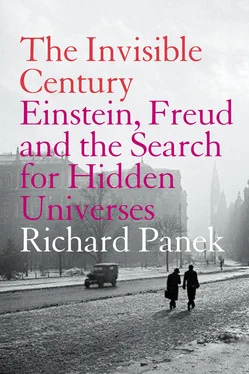Only five years later, however, British physicist Joseph Jackson Lister effectively revolutionized the microscope through improvements to the objective lens—the one nearer the specimen—that mostly eliminated distortions and color aberrations. Before this advance, neuroanatomy hadn’t been much more than speculation supported by inadequate, incomplete or imprecise observation—supported by further speculation even. Now a new breed of anatomist could explore tissue at a level of detail that was literally microscopic—the technique that would become known as histology.
In 1827, only a year after inventing his achromatic microscope, Lister himself (along with the physician Thomas Hodgkin) decisively refuted all the variations on Leeuwenhoek’s “globular” hypothesis that had arisen over the preceding century and a half. The globules, it turned out, were illusions, mere tricks of the light that Lister’s new lens system could now correct. By utilizing the achromatic microscope to examine brain tissue, Lister reported, “one sees instead of globules a multitude of very small particles, which are most irregular in shape and size.” To these particles anatomists applied a term that the first microscopists back in the seventeenth century had used to describe some of the smallest features they could see, though now it came to refer only to the basic units of organisms, both plant and animals: cells. These cells, moreover, seemed always to be accompanied by long strands, or fibers. That a relationship between these cells and fibers existed in the central nervous system—the brain and spinal cord—formed the basis of Theodor Schwann’s cell theory of 1839, a tremendous advance in knowledge from even fifteen years earlier. “However,” as one researcher reported in 1842, “the arrangement of those parts in relation to each other is still completely unknown.”
Some researchers argued that the fibers merely encircled the cells without having an anatomical connection to them. Some argued that the fibers actually emanated from the cells. Such was the density of the mass of material in the central nervous system, however, that even the achromatic microscope couldn’t penetrate it sensibly. Despite the promise of clarity that Lister’s improvements at first had seemed to offer, by the 1850s anatomists were beginning to resign themselves to the realization that the precise nature of the relationship between cells and fibers would have to remain a mystery, unless another technological advance came along.
It did, in 1858, two years after Freud was born, when the German histologist Joseph von Gerlach invented microscopic staining—a way to dye a sample so that the object under observation would bloom into a rich color against the background. The object under observation in this case was a central nerve cell, complete with an attendant network of fibers. Now neuroanatomists could see for themselves that the fibers and the cells were indeed anatomically connected. They could also see that the central nerve cells exist only in the gray matter of the brain and spinal cord, never the white. And they could see that even where a central nerve cell is part of a dense concentration within the gray matter, it exists apart from any other central nerve cell, in seeming isolation.
But if the cells themselves don’t come into contact with other cells, then how do they communicate with one another, as they clearly must? How does one cell “know” what the others are doing and therefore act in concert and thereby register a sensation or commit the nervous system to a response, an action, a thought? If the answer wasn’t in the cells, those solitary hubs, then it had to be elsewhere.
And the only elsewhere there was, was the fibers. Thanks to Gerlach’s staining method, neuroanatomists now found that the fibers extend from the central nerve cells only into the white matter of the brain and spinal cord, never the gray. But there the trail went cold. The meshwork was still too intricate for anyone to trace the paths of all the fibers from a single cell to the point where the fibers terminate. And so yet another technical innovation needed to be invented, and so yet another one was. In 1873—the same year that Freud entered the University of Vienna as a medical student—Camillo Golgi, an Italian physician, developed a superior staining method that in effect isolated the fibers in the same way that Gerlach’s had isolated the cells. Even so, researchers still couldn’t find one point of connection between the fibers of two different cells. Golgi himself thought he found one in the 1880s, but his sample was inconclusive. Still, in order to do what central nerve cells do, which is pass along impulses to one another, both prevailing theory and common sense dictated that the fibers of neighboring cells must connect, somewhere.
Not until 1889 did the Spanish histologist Santiago Ramón y Cajal discover the truth: They don’t, anywhere. This , then, was the basic unit of the brain, what the German anatomist Wilhelm Waldeyer two years later would name the neuron: each central nerve cell and its own fibers, existing apart from—that is, not connecting to—any other central nerve cells and their own fibers. But if even the least wisp of a fiber—a fibril—doesn’t connect, what does it do? It contacts , Ramón y Cajal explained. It reaches out, under the excitation of an impulse, to touch the neighboring fibril or cell, and then, when the excitation has relaxed, it retracts to its previous state of isolation. “A connection with a fiber network,” Waldeyer wrote, “or an origin from such a network, does not take place.”
Although at first the “neuron doctrine,” as Waldeyer christened it, might have seemed to contradict common sense, upon reflection the idea that communication between individual neurons was not continuous but intermittent actually went a long way toward a possible explanation of several otherwise inexplicable mental phenomena, such as the isolation of ideas, the creation of new associations, the temporary inability to remember a familiar fact, the confusion of memories. These were the phenomena, anyway, that Freud had been confronting in his private practice, where he found himself listening at length to hysterics, and wondering how to represent their worries and cures within the webwork of cells and fibers he remembered from his years of neuroanatomy.
“I am so deep in the ‘Psychology for Neurologists’ that it quite consumes me, till I have to break off overworked,” Freud wrote to a friend in April 1895. “I have never been so intensely preoccupied by anything.” By now Freud had embarked on a second career. From 1873 to 1885, first as a medical student and then as a medical researcher, he’d devoted himself to an examination of the nervous system—to research in neuroanatomy. In 1886, on the eve of his thirtieth birthday, he’d opened a private practice devoted to nervous disorders and, for the first time in his life, begun seeing patients, though he continued to conduct research on the side. After the development of the neuron theory, Freud would have had every reason to believe that if anyone were in a position to unite the psychical with the physical, it was he. He’d seen both sides. He’d studied both sides, immersing himself in the peculiar logic of each for long periods of time. He’d even written some tentative outlines to this effect over the past few years, in letters to his closest friend and constant correspondent, Wilhelm Fliess, a Berlin ear, nose, and throat doctor. Not until Freud could meet with Fliess personally late in the summer of 1895, however, and the two men could convene one of their days-long “congresses,” as Freud liked to call these occasional periods of intense and inspirational professional discussion, did he see the project whole.
Читать дальше











